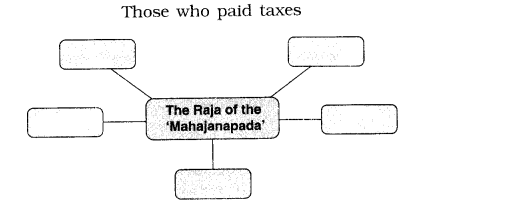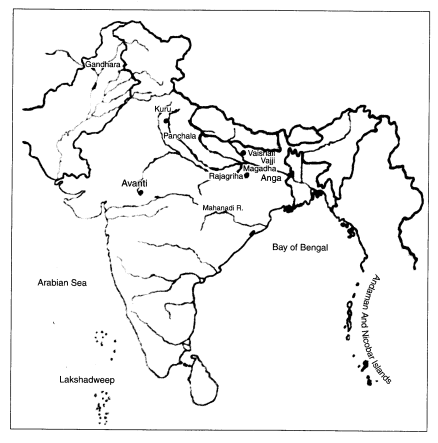NCERT Solutions for Class 6th Social Science History Chapter 6 Kingdoms, Kings and an Early Republic
1. State whether true or false:
- ‘Rajas’ who let the ‘ashvamedha’ horse pass through their lands were irwited to the sacrifice.
- The charioteer sprinkled sacred water on the king.
- Archaeologists have found palaces in the settlements of the ‘janapadas’.
- Pots to store grain were made out of Painted Grey Ware.
- Many cities in ‘mahajanapadas’ were fortified.
Answer.
- True
- False
- False
- True
- False.
2.Fill in the chart given below with the terms: hunter-gatherers, farmers, traders, crafts-persons, herders. ‘

Ans:
Hunter-gatherers, farmers, traders, crafts-persons and herders—all paid taxes.
- Farmers—one-sixth of the produce.
- Crafts-persons—in the form of labour.
- Herders—in the form of animals and animal products.
- Traders—taxes on goods brought and sold.
- Hunter-gatherers—forest produce.
3. Who were the groups who could not participate in the assemblies of the ‘ganas’?
Ans:
These groups of people were not allowed to participate in the assemblies of the ‘ganas’.
- Women
- ‘Dasas’
- ‘Kammakaras’.
4.Why did the ‘rajas’ of ‘mahajanapadas’ build forts?
Ans:
- The rajas of mahajanapadas built forts to protect their capital city.
- This means that huge walls of wood, brick or stone were built around them. Forts were probably built because people were afraid of attacks from other kings and needed protection.
- It is also likely that some rulers wanted to show how rich and powerful they were by building really large, tall and impressive walls around their cities. Also in this way, the land and the people living inside the fortified areas could be controlled more easily by the king.
5. In what ways are present-day elections different from the ways in which rulers were chosen in ‘janapadas’?
Ans:
- Present day elections are conducted by election commission. In janapadas we did not have election commission. Some of the rajas were probably chosen by the jana, the people. But around 3,000 years ago, we find some changes taking place in the ways in which rajas were chosen. Some men now became recognised as rajas by performing very big sacrifices.
- In present-day elections, all citizens (including women and dasas etc.) participate in election process after 18 years of their age. But in janapadas all free men over the age of 30 were recognized as full citizens. In janapadas women and slaves were not considered equal free citizens.
- Appointments for rulers were made through lottery. All those who wanted to be chosen gave in their names and then some were selected through lottery.
6. Find the state in which you live in the political map on page 136. Were there any ‘janapadas’ in your state? If yes, name them. If not, name the janapadas’ that would have been the closest to your state, and mention whether they were to the east, west, north or south.
Ans:
The answer depends on the region you live in. Take the help of your teacher and the map given on page 57 in the textbook to prepare your answer. However, a sample answer has been provided (using the state Uttar Pradesh) – The ‘janapadas’ in the present-day Uttar Pradesh—Panchala, Kosala.
7. Find out whether any of the groups mentioned in answer 2 pay taxes today.
Ans:
Yes, all of the groups mentioned in answer 2 pay taxes today.
8. Find out whether the groups mentioned in answer 3 have voting rights at present.
Ans:
Yes, all the groups (full citizens of a state or country of age 18 or above (including men, women, dasas, kamakaras etc.) have voting rights at present.
I.MULTIPLE CHOICE QUESTIONS
Choose the correct option to complete the statements given below:
(i) The ‘Ashvamedha’ was the sacrifice of
(a) horse
(b) cow
(c) bull
(d) goat
(ii) Which of these groups of people were not allowed to take part in the rituals after the ‘Ashvamedha’?
(a) ‘Vish’/’Vaishya’
(b) Priests
(c) Women
(d) ‘Shudras’.
(iii) The two words that constitute the word ‘janapada’ mean:
(a) woman and foot
(b) citizens and foot
(c) men and hand
(d) goats and ‘rajas’.
(iv) Which of these was usually fortified?
(a) all cities in ‘mahajanapadas’
(b) all cities in ‘janapadas’
(c) capital cities of ‘mahajanapadas’
(d) the whole ‘mahajanapada’.
(v) One-sixth of the produce was taken as tax from
(a) farmers
(b) hunter-gatherers
(c) crafts-persons
(d) Traders.
(vi) The present name of Raj agriha is
(a) Rajgir
(b) Rajmahal
(c) Rajgaon
(d) Patna.
(vii) Alexander was a ruler who lived in
(a) Slovenia
(b) Greece
(c) Rome
(d) Macedonia.
(viii) At the banks of which river did Alexander’s troops stop?
(a) Indus
(b) Ganga
(c) Narmada
(d) Beas.
(ix) Vajji had its capital city at
(a) Raj agriha
(b) Vaishali
(c) Patna
(d) Magadha.
Answer:
(i)—(a), (ii)—(d), (iii)—(b), (iv)–(c), (v)—(a), (vi)—(a), (vii)—(d), (viii)—(d), (ix)—(b).
III. FILL IN THE BLANKS
Fill in the blanks with appropriate words to complete each sentence:
- Some changes took place in the ways of choosing new ‘rajas’ about………………….. years ago.
- Purana Qila was a settlement in a ‘janapada’ and is now located in ………………………
- Archaeologists have discovered that people in ‘janapadas’ lived in ……………………….
- Painted Grey Ware is a type of…………………
- The taxes on crops were called ………………
- Herders were supposed to pay taxes in the form of…………………….
- ‘Kammakara’ was a word used for …………………
- A ruler called……….. extended the control of Magadha up to the northwest part of the subcontinent.
Answer.
- 3000m
- New Delhi
- (iii) huts
- potteiyr
- ‘bhaga’
- animals and animal produce
- landless agricultural laburers
- Mahapadma Nanda.
III.TRUE/FALSE
State whether these sentences are true (‘I’) or false (F).
- The sprinkling of sacred water on the king was done by the ‘Shudras’.
- The word ‘janapada’ means the land where the ’jana’ has set its foot.
- Capital cities were fortified with huge walls of wood, brick, or stone.
- The rulers of ‘mahajanapadas’ depended on occasional gifts brought by people,
- The rivers Narmada and Brahmaputra flowed through Magadha.
- Alexander was the only person who conquered Magadha.
- Both the Buddha and Mahavira belonged to ‘ganas’ or ‘sanghas’.
Answer.
- F
- T
- T
- F
- F
- F
- T
IV.MATCHING SKILL
Match the items in column A correctly with those given in column B,

V.VERY SHORT ANSWER TYPE QUESTIONS
1. Name a ritual used to recognise someone as a ‘raja’.
Ans:
‘Ashvamedha’ was one ritual used to recognise kings.
2. Which category of people was excluded from the rituals?
Ans:
The ‘Shudras’ were excluded from rituals,
3. Name two ‘janapadas’ in North India.
Ans:
Hastinapura and Atranjikhera.
4. How were cities fortified?
Ans:
Cities were fortified by building huge walls of wood, brick or stone around them,
5. For what did rulers need taxes?
Ans:
Rulers needed taxes to build huge forts and to maintain big armies,
6. Name tivo rivers that flowed through Magadha.
Ans.
Ganga and Son were two rivers that flowed through Magadha.
7. Name some places conquered by Alexander.
Ans:
Alexander conquered parts of Egypt and West Asia.
8. Which rulers conquered the last of the ‘ganas’ or ‘sanghas’?
Ans:
The Gupta rulers conquered the last of the ‘ganas’ or ‘sanghas’.
VI.SHORT ANSWER TYPE QUESTIONS
1. Write a short note on the ‘Ashvamedha’ ritual
Ans:
The ‘Ashvamedha’ (horse sacrifice) was a ritual used to recognise men as ‘rajas’. A horse was left to wander freely. If it wandered into another kingdom and the king of that kingdom stopped it, they had to fight. The ‘raja’ who succeeded in the challenge was recognised as stronger. He would then perform the sacrifice, in which other kings would also come.
2. What were the different roles of different persons in the sacrifice? [V. Imp.]
Ans:
The ‘raja’ was the central person in the sacrifice. He was given a special seat, like a throne. His charioteer would tell others tales of the ‘rajas’ exploits. His wives and sons would perform several minor rituals. Other ‘rajas’ would sit and watch. Priests sprinkled sacred water on the king. Ordinary people brought gifts.
3. What is known about the ‘janapadas’ and their people?
Ans:
Archaeologists have excavated a number of settlements in ‘janapadas’. They have found that people lived in huts. The people kept cattle as well as other animals. They grew a variety of crops like rice, wheat, barley, pulses, etc. They made earthen pots, some of which were grey in colour and some red.
4. Write a short note on the governance system in ‘ganas’ or ‘sanghas’? [V. Imp.]
Ans:
In ‘ganas’ or ‘sanghas’, these were not one but many rulers. Even if there were several men together, each was called a ‘raja’. They performed rituals together. They met in assemblies and took decisions. Women, ‘dasas’ and ‘kammakaras’ were not allowed to participate in these assemblies.
VII.LONG ANSWER TYPE QUESTIONS
1. What was the important feature of the capital cities of ‘mahajanapadas’? Why were they fortified? How were they fortified? [V. Imp.]
Ans:
Capital cities of ‘mahajanapadas’ were mostly fortified by building huge walls of wood, brick or stone around them. There were various reasons for building forts. They were probably built because people were afraid of attacks from other kings and needed protection.
Some rulers probably built forts to make their cities impressive and to show how rich and powerful they were. Moreover, by making forts, controlling the fortified area became easier for the kings. Buildings forts required a great deal of planning. Hundreds of thousands of brick or stone had to be prepared. An enormous amount of labour and resources were required.
2. What changes took place in agriculture around this time? [V. Imp.]
Ans:
There were two significant changes in agriculture around this time:
(i) Growing use of the iron ploughshares helped in yielding better grain produce. Heavy, clayey soil could be turned over better with an iron ploughshare than with a wooden ploughshare.
(ii) People began transplanting paddy. This meant that instead of scattering seed on the ground, from which plants would sprout, saplings were grown and then planted in the fields. Production developed due to this since many plants survived.
VIII.MAP SKILLS
1. On an outline physical map of India, mark these ‘janapadas’ or ‘mahajanapadas’.
(i) Gandhara (ii) Kuru
(iii) Panchala (iv) Kosala
(v) Avanti (vi) Magadha
(vii) Anga (viii) Vajji.
Ans:

NCERT Solutions Maths Science Social English Hindi Sanskrit RD Sharma